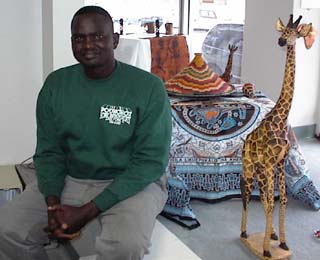|
BB
gun shooters nabbed [MARCH
31, 2000] Two
17-year-old males have been charged with 26 counts of
criminal damage to property resulting from window damage
that was done last week to various vehicles and homes
throughout Lincoln. A 14-year-old juvenile male may also
be charged with as many as 19 counts of criminal damage to
property.
Sergeant/Detective
Ric Bacon of the Logan County Sheriff’s Department led
to the charges of the three individuals being filed by the
Logan County State's Attorney Office. Bacon was
unavailable for comment this morning.
The
Lincoln Police Department assisted in the investigation.
The
two males charged are of 1740 600th Ave. and
212 Palmer respectively. Both defendants were also charged
with additional counts in an unrelated matter. Their bonds
were set at $7,500, 10 percent of the reported damage.
[LDN]
|
|
|
Raising
school spirit The
story behind fundraising [MARCH
30, 2000] Fundraising has become a means to "the extras" for
school districts in Logan County. Students, parents and
teachers raise thousands of dollars each year to purchase
additional items for students and for the schools. Lincoln
Community High School has more than 40 student and booster
clubs. Each student club, such as the French, library and
national honors clubs, are allowed to have one fundraiser
each year, while the booster clubs have 10 to 12 annual
fundraisers.
|
|
"We
sell everything," said Darrell Hanslow, activity
director for LCHS, "There is a fundraiser going on
every week of the year." He added, "I'd estimate
that our annual fundraising efforts raise over $50,000 per
year, with most of these funds being raised by the booster
clubs for the athletic teams." This is in addition to
the $300,000 that the school provides per year for school
athletics.

[Posters like this one promote the
importance of reaching the fundraising goal]
West
Lincoln-Broadwell’s Parent Teachers Organization (PTO)
and booster clubs hold annual chili suppers and pancake
and sausage breakfasts. The school also participates in
Market Day, a fundraiser that sells packaged food
throughout the year. This year's fundraising profits have
been earmarked for a learning garden that will be planted
on the school's property this spring, according to Terrica
Buchholz, the school’s secretary.
The
fundraising cooperative Market Day earns Chester-East
Lincoln (CEL) $300-$600 per month according to Kathy
Martinie, the program’s parent coordinator. Martinie
places the orders and Ron Ackerman, a CEL parent, takes
care of the distribution of the products. "It has a
large following, with a good group of supportive parents
who go above and beyond the call to help the
students." This year’s profits from Market Day and
community club activities, a PTO project, will go toward
purchasing books for a reading program that encourages
reading at all ages.
|

In
addition to items sold by students, the school also
participates in corporate fundraisers by collecting labels
and points from cereal boxes, cans and other products.
These proof of purchase seals are then turned in to the
companies in exchange for software, rewards and money.
Most of CEL’s fundraisers are school-wide efforts. The
administration surveys the staff each year to determine
how the profits will be used.
Judy
Alberts, principal at CEL, said their fundraisers collect
about $6,000-7,000 annually. This is in addition to an
activity fee that is collected with each student’s
registration fees. Alberts commented, "Teachers are
energetic about the fundraisers. The trend is to do
something different. I think we’ve done that. Our
fundraising success lies in the variety of items that we
offer, and we don’t overlap fundraisers."
All
of the eighth graders raise money to be put towards
expenses for their class trip, usually to Chicago or St.
Louis.

[Kathy Martinie, Ron Ackerman and Judy
Alberts take pride in Chester-East Lincoln fundraisers]
Each
of the schools contacted expressed gratitude to the
community, parents, and teachers who have helped their
respective schools raise funds.
[Kym
C. Ammons-Scott]
|
|
|
Save Our Schools Committee
seeks enforcement from "preservation police"
[MARCH
29, 2000] The
Save Our Schools Committee, a group of Lincoln residents
dedicated to preserving Central Elementary and Lincoln
Junior High Schools, met Tuesday evening to explore ways
to continue efforts to prevent the buildings from being
demolished. Earlier this month the District 27 School
Board approved replacing both schools with new facilities.
|
|
"Obviously
the decision at the March board meeting changed the
picture dramatically for us," said Valecia Crisafulli,
who chaired the meeting. "We are no longer trying to
convince the board to change something already past and
decided. A lot of you have spoken eloquently before the
board but have not been heard. We are looking at a shift
in focus," she told the 25 members who attended.
That
shift will include using influence at the state level to
try to preserve the schools. Guest speaker Stephen A.
Thompson of the Illinois Historic Preservation Agency
outlined the type of review process Central and Lincoln
Junior High will have to go through if they are to get the
73 percent state funding which the school district is
applying for. He indicated that the mandatory review by
his agency could provide a means to prevent, or at least
delay, the demolition.
A
law which went into effect in 1990, the Illinois State
Agency Historic Resources Preservation Act, requires that
an evaluation be made of any state-funded project to
determine whether the site is a historic resource and
whether the proposed project would have an "adverse
effect" on the resource. Thompson is the resource
protection manager of the Preservation Services Division,
a position he described as the "preservation
police."
Agencies
undertaking projects using state funds, such as the
construction of schools, are required to notify the
Illinois Historic Preservation Agency. "They come in
and tell us what they’re doing," Thompson said.
"About 25 percent of the projects could very well be
historic resources."
The
IHPA looks at the architecture and engineering
immediately, he said, and then determines if the site in
question meets the requirements set by the National
Register of Historic Places. One such requirement is that
the site must have a "social history" in the
community, and schools such as Central Elementary and
Lincoln Junior High would meet that criterion, he said.
His
agency might consider demolition of a building an
"adverse effect" if there are no other new
buildings in the neighborhood or if the area is a historic
district, he added. After determining that there is an
"adverse effect," his agency would ask that the
applicant for funding (in this case District 27) to look
for a "feasible and prudent alternative" to the
original plan.
|

If
no alternative can be agreed on, the state agency in
charge of the project, probably the Illinois State Board
of Education, must hold a public hearing at which all
interested parties may speak. After this review, if the
Historic Preservation Agency still believes there is a
"viable alternative," the issue goes to a
mediation committee. However, Thompson said in the 10
years he has been with the agency no project has gone
through the entire process.
He
pointed out that in order to get funding for the two new
schools, the District 27 school board must apply to the
Illinois State Board of Education, which then submits the
project to the state’s Capital Development Board. After
that an environmental impact study is done, which includes
the review by the Historic Preservation Agency.
"Somebody has to sign off so they (CDB) can release
the funds. We come in at the end," he commented.
"Can
you actually shut down a project?" one committee
member asked.
"I’ve
done it," Thompson replied.
Members
discussed other avenues that might help their cause.
Lincoln resident, Joyce Kinzie said she believed the
public did not have adequate information about the
specifics of the district’s plan. "Before
demolition and a building program take place we should
have information from the administration on what the
projected needs of the district are and what kinds of
space not now available will be needed."
Paul
Short, also of Lincoln, said the committee should continue
to let everyone know that it wants to deal openly and
positively with the school board and the state agencies
involved.
The
committee will schedule another meeting in May, but no
date has yet been set.
[Joan
Crabb]
|
|
|
Part 2 of 3
A
mission of mercy
The
story of a local woman’s compassion for the Pokot people
[MARCH
28, 2000] In
1997 Barb O’Donohue took a trip which changed her life.
She traveled with Lincolnites Dr. Paul and Mary Boatman to
the remote African village of Tapandany. While there she
caught the vision begun by a 1993 graduate of Lincoln
Christian Seminary, the Honorable Samuel
L. Poghisio, a member of the Kenyan Parliament.
|
|
In
1995, while the Boatmans were with Poghisio, he shared
with them the need for a school in that village. Poghisio’s
sister went to the village and began teaching the children
sitting under a tree. The school continued to grow with
some support from the Lincoln community, but there was a
need for a more formal organization and someone to
administrate it. "Our primary goal [for this trip]
was to solidify the relationship there," Dr. Boatman
stated.

[While they live in
villages with
dirt floors and small huts, the Pokot
people receive generous gifts
of clothing from the United States, including
donations from organizations in Lincoln. Notice the young
boys Lincoln Area
YMCA t-shirt]
On
O’Donohue’s first visit to Tapandany, she connected
with the people and the job at hand. Returning home, she
set to work. "Barb’s administrative skills just
kicked in," Boatman commented. She got to work filing
all the proper paper work for an organization to provide
coordination for the projects in Tapandany.
What
O’Donohue saw and felt while meeting the Pokot people
moved her heart and soul. She says, "I was struck
deep by the people." She came back focused on the
things that needed to be done. She redirected her own
life, making sacrifices that would affect her daily life.
Her priorities now included the Children of Pokot
Education, COPE. She had the upstairs of her downtown
business, General Consulting Services, remodeled so she
could live there, and she redesigned the structure of her
business so she could travel
and spend time, four to six weeks at a time, in the
village a of couple times each year.
While
looking through a few of the pictures that vividly reflect
village life, Barb comments, "Some people would look
at these people and say that they are primitive. They are
not primitive, they are a highly evolved culture."
The Pokot people, once a nomadic tribe, have become what
is termed a "marginal people." They have settled
and are no longer able to move to more bountiful areas of
land. They must make a living in a place where the land
quality is poor. Living is a challenge. "These are a
people that are at risk for extinction," Ms. O’Donohue
says. "I truly cannot imagine this earth without the
Pokot. Somehow, they add a grace and rhythm to this earth.
There would be this hollow sound or lack of sound without
them."
Droughts
continue to take a toll in this region. Several years of
drought have reduced much of the food supply. Hunger is a
daily reality. Some of the children come to school just
because they know they will get what might be their only
meal that day.
The
Pokot are a culture in which the women are the laborers.
While the men gather and discuss world issues, the women
do the work. After laboring in the fields and caring for
their families, the women will gather and not sit. They
continue to work, sometimes intricate beadwork which is
sold at market, as they discuss their families. A primary
COPE goal is to establish cottage industries to help
supplement the villager’s income.
In
terms of life and work, O’Donohue speaks of "Pokot
time." The speed with which something gets done in
Pokot is not the same as we would expect in the western
world. It is quite the opposite to "a New York
minute." Pokot-time is more like that of a rabbit
which runs, then stands stock still, and may, after some
prodding, take off running again. Though she was often
frustrated at first, O’Donohue has learned to recognize
some of the functional and cultural roadblocks the
villagers are up against.
|
"Sometimes
they run out of materials," she emphasizes, "and
so a project will just come to a standstill until I get
there and get it going again." Often it is a lack,
loss or temporary displacement of vision, which curtails a
project. "It has been an extremely valuable life
lesson for me," she says with a laugh, "learning
to live in Pokot-time."
As
an example, the recently completed block schoolhouse was
made three blocks at a time because there were just three
molds. When 1,500 of the blocks were made, the men ran out
of cement. There was a wait for funds for the remaining
1,500 blocks to be made. Though long after the scheduled
time for completion, the 3,000 blocks were assembled and
the new schoolhouse was completed. According to O’Donohue,
the villagers are now taking great pride and ownership in
it. They enthusiastically talk about coordinating green
uniforms with the green roof and ponder how to raise
school fees for study materials. "They are very proud
of their accomplishment," she adds.
Having
a school started is not enough to make a permanent
difference in the lives of the villagers, however. With
her skillful insights, O’Donohue continues to pick and
choose projects that guide the villagers into
self-sufficiency and a better quality of life. With
education and health of the children at the center of
COPE, she has taken into effect many influential factors
and implemented a number of other projects to help the
community. At present, the proposed projects include a new
school building, daily meals for the children, seeds for
crops and nutritional guidance, an irrigation system,
immunizations, basic medications, hygiene and drinking
water education, a community well which Lincoln
Rotary Club is helping with, and cottage
industries such as making ovens, bread, and jewelry to
sell at market or in nearby communities. O’Donohue also
wants to find ways to provide basic medical and dental
care.

[O'Donohue learns a few new dance steps
during a celebration]
By
taking the time to live in the village, O’Donohue has
gotten to know the needs and abilities of the people. Her
dedication has been of immeasurable value to the village,
but if you ask her, she might say she has been the greater
beneficiary. She will tell you how much she has fallen in
love with the people. She remembers each one by name,
every day, even when she is away from them.

[Daily sustenance is called "Ugi"
by the Pokot people]
Editor’s
note: When O’Donohue returns from her stint in
Africa, LDN will catch up with her to see what she did on
her recent visit with the Pokot people.

[A young woman seeks medical attention from
O'Donohue]
[Jan
Youngquist]
|
|
|
Part 1 of 3
Lincoln's
helping hands reach all the way to Africa
Barbara
O’Donohue on the way to Kenya
[MARCH
6, 2000]
What
is on your agenda for this week? If you could sneak a peek
at one Lincoln woman’s daily planner, it might look like
this: This week’s agenda: Go to a small, remote village
in Africa. Stay in "mud huts, graciously shared by
the most wonderful people you could meet."
|
|
Owner
and president of a Lincoln-based business, General
Consulting Services, Barbara O’Donohue left the States
March 5th for a return trip to Kenya. She will
be working as a volunteer for the Children of Pokot
Educational Fund (COPE), an organization she helped found.
The Pokot village she will be visiting is located in the
country of Kenya, in the Kacheliba District. This will be
one of Ms. O’Donohue’s shorter trips, taking four
weeks instead of the usual five or six. She will be
working with tribal leaders, women, educators and other
villagers.

[Barbara O'Donohue and Sam Poghisio]
How
did Ms. O’Donohue, a Lincoln businesswoman, first
connect with a village in Africa? The story begins with
Sam Poghisio, a Kenyan who attended Lincoln Christian
Seminary.
Poghisio
was an exile from Kenya when he arrived in Lincoln in the
early '90s. He came on a scholarship to Lincoln Christian
Seminary. Back in Kenya Poghisio had been a member of
Parliament. He was expelled from the Parliament during a
difficult political time. Poghisio’s strong stances had
provoked those in power, and his safety was endangered.
Shortly after Poghisio came to Lincoln, his wife, Pauline,
joined him. Mrs. Poghisio was about to give birth to the
couple’s first child and had been unable to attain a
visa. After the birth of their daughter, Chelimo, Mrs.
Poghisio was granted a visa and came to join her husband.
Poghisio
earned his master of divinity degree in 1993, and the
family returned to Kenya the following year. He took a
professorship at Africa’s largest Christian university,
Nairobi’s Daystar University. He resumed his works for
his people and was elected back into the Parliament of
Kenya in 1998.
|

Paul
and Mary Boatman of Lincoln were traveling with Poghisio
in 1995. During that visit in a remote village of the
Pokot province, the Boatmans learned of the needs of Pokot.
They observed children milling around, children who should
have been in school. There are no schools readily
accessible in the remote area around Pokot. Poghisio
explained to the Boatmans that the children of this
village grew up without education. The boys became tribal
warriors, and the girls married the boys.
Poghisio
dreamed of educating the children of Pokot, and asked his
well-educated sister if she would go there to teach. She
agreed. Poghisio’s sister opened school under a tree.
After
seeing the children and meeting the villagers during her
visit to the village, O’Donohue caught the vision. She
came home inspired by the wonderful people. With the
support of the Boatmans and other Lincolnites, she took on
the leadership to establish COPE, which has helped the
school to grow.
Later,
the class moved to a shelter, a grass hut where the
children sat on dirt floors. Since then, a new building
has been constructed, and the school children will soon
move into it. The little schoolhouse has a concrete floor,
tin roof and no desks. It is divided into five rooms.
Poghisio smiles and says proudly, "The children will
no longer have to sit in the dust."

[Poghisio poses with artifacts of his native
country]
Four
teachers and 150 children are looking forward to moving
into the new school. They now claim one of the highest
enrollments in the district, and the school is one of the
few offering a Bible-based education. Lincoln people have
joined the Boatmans and Ms. O’Donohue in supporting the
schoolhouse in Pokot.
Sam
Poghisio recently returned to Kenya after a brief visit to
the States. He was here with many other world leaders on
an invitation to the National Prayer Breakfast in
Washington, D.C. The members of the U.S. Congress hosted
the breakfast, with the President and Mrs. Clinton also in
attendance. Poghisio swung though Lincoln to see some of
his friends here and to express his great appreciation for
the people who support COPE.
[Jan
Youngquist]
(Part
2)
|
|
|
Schools
to go down
[MARCH
16, 2000] In
an unexpected move, Lincoln Elementary School District 27
school board voted Wednesday night to rescind last
month’s decision to renovate Central Elementary School
and to approve replacing both Central Elementary and
Lincoln Junior High School with new facilities.
|
|
The
change in plans came after Superintendent Robert Kidd
reported that he had received little support from the
Lincoln City Council for permission to move a 6-by-6 foot
city sewer line that runs across Ralph Gale Field. The
sewer would have to be moved before the school district
could complete its original plan to build a new school on
that site.
Although
the City Council meeting held Tuesday evening was a work
session and no official vote was taken, Dr. Kidd said
there did not appear to be support for moving the sewer,
but instead appeared to be opposition. He said aldermen
opposed changing the big walk-in sewer line that was
functioning well and also cited opposition from
constituents who want to keep Ralph Gale Field as open
space.

After
hearing Kidd’s report, board member Bruce Carmitchel
moved to rescind the motion to renovate Central School. A
second motion was made to adopt a plan which Dr. Kidd had
submitted earlier, which calls for building two new
schools: a new Central School facility on the same lot,
facing Seventh Street, and a new Lincoln Junior High
School.
Both
motions passed 5-2, with Board President Bill Bates and
Leta Herrington voting no.
Bates
said he voted against the motion because he was not in
favor of demolishing both of the existing school
buildings. He said he favored building a new Central
School facility but not demolishing the junior high school
at this time.
|
Mayor
Joan Ritter told the Lincoln Daily News this
morning that although aldermen said they had received
letters from constituents who wanted to keep Ralph Gale
Field, the only issue addressed by the council Tuesday
evening was the sewer line itself.
She
said that, based on the relocation of the sewer line,
"There was just not enough technical information
given to the council, city engineer and sewer treatment
plant manager for the city to give the school board a
commitment at this time.
"This
is a major trunk line, six feet wide, all brick. Sewer
plant manager Grant Eaton said the plans were not detailed
enough for him to advise the council how to make a
decision," she said.
Dr.
Kidd said he believed Wednesday night’s decision would
be the end of the controversy over saving Central School.
"We have to have all proposals in to the State Board
of Education by April 1, and we have no more meetings
scheduled until after that date," he noted.
If
approved by the State Board of Education, the new building
projects will get 73 percent of their funding from the
state of Illinois, with the rest coming from a local bond
issue. Approval from the state board probably will not
come before early summer, Kidd said.
After
that, district voters will have to approve a bond issue
for the remainder of the funding, which would go on the
ballot either in November or at the next municipal
election in April of 2001.
"The
earliest time we could possibly see dirt turned would be
the summer of 2001," Kidd said. The new plan calls
for building a new Central Elementary School at the back
of the present school lot, moving junior high students
into the existing Central facility, then constructing a
new junior high school. There are approximately 280
students in both Central Elementary and Lincoln Junior
High School, Kidd said.
[Joan
Crabb]
(Back
to March 29 story)
|
|
Back
to top
|
|
Top
Stories | Sports
Talk | Weather
A
Day in the Life | Milestones
| Obituaries
| Diaspora
Business
& Ag | Organizations
& Events | Good
Neighbors | Honors
& Awards | Ombudsman
| Law
& Courts
Crosswords
| Hearsay
& Hairspray |
The
Arts | Family
Life | Spiritual
Life | Health
& Fitness | Teaching
& Learning | Book
Look | Movies
& Videos
the
em space | Where
They Stand | How
We Stack Up | By
the Numbers
Letters
to Editor | About
LDN | Corrections
| Happy
Ads | Classified Ads
|
|



